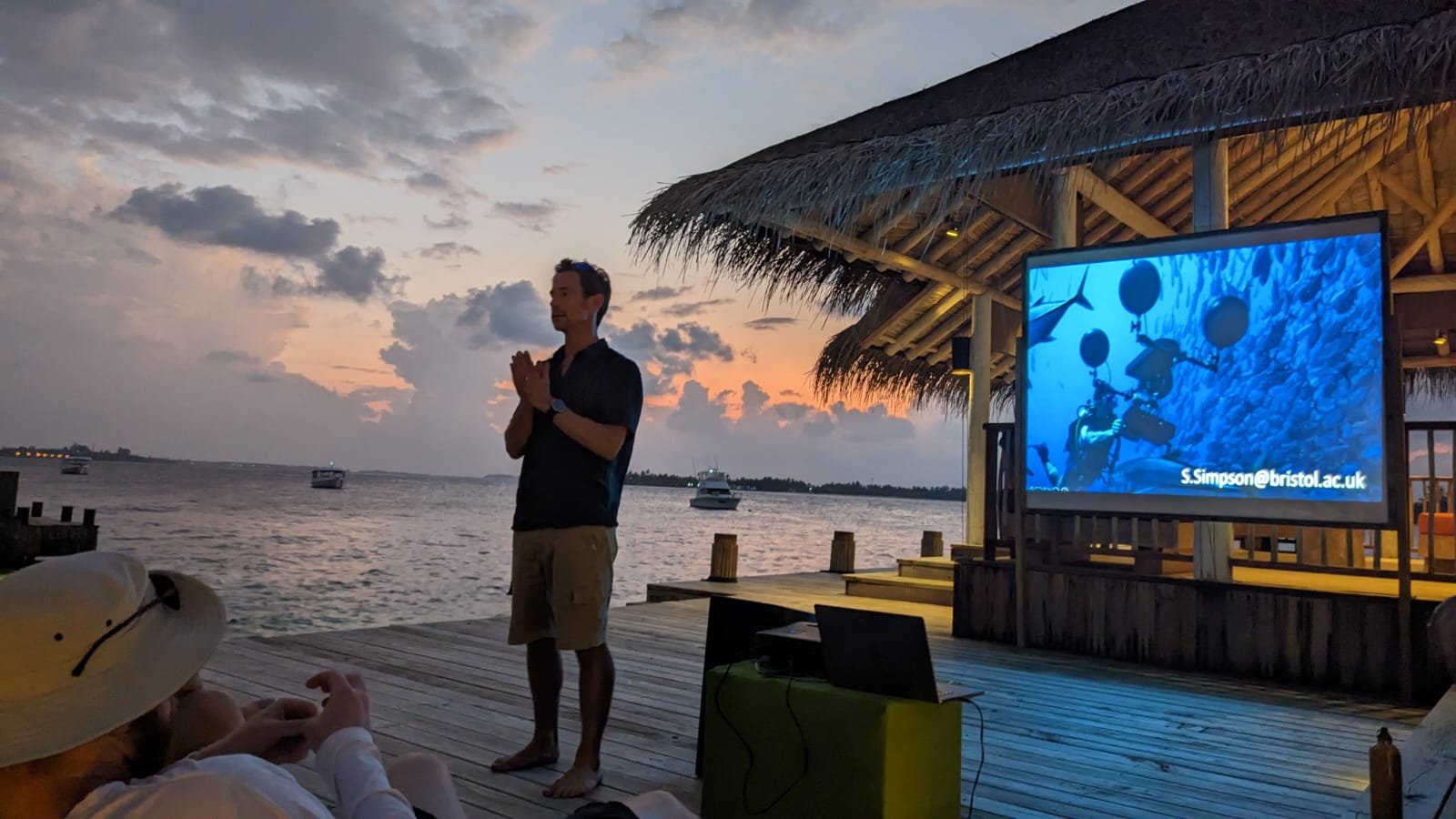Diving into the Acoustic Secrets of Laamu Atoll
January 2024
The Manta Trust team in Laamu Atoll, based at Six Senses Laamu, have started an exciting new collaboration with the University of Bristol (UK). With what the researchers call their "Ears on the Reef" project, the team hopes to focus more on the often-overlooked underwater soundscape, an important step in understanding the lesser-known language of our ocean’s creatures and ecosystems. It is a first step in exploring the acoustic soundscape of manta ray cleaning stations and aggregation sites in Laamu Atoll in the Maldives.
360 camera and HydroMoth acoustic device on manta ray cleaning station. © Miriam Staiger
The connection with the University of Bristol was made in March 2023, when Professor Steve Simpson visited Six Senses Laamu and the Maldives Underwater Initiative (MUI) as part of a documentary project for the BBC/PBS Our Changing Planet series. During conversations with MUI, the Manta Trust team got incredibly excited about the potential of this work and started to wonder whether they could explore cleaning station soundscapes, answering questions as to what acoustic cues manta rays might utilise and whether human noise pollution has an impact on their behaviour or on other fish at the cleaning stations.
This is when Prof. Simpson and the team started making plans and agreed on a new project, and the “Ears on the Reef” project was born. As you might know, for quite some time now the Manta Trust has been working on their “Eyes on the Reef” project, which are remote underwater camera systems that are deployed on manta ray cleaning stations to record animal behaviour and cleaning station activity when humans aren’t there. Now that the team has eyes and ears on reef, we wonder what’s next in discovering the unique senses of the underwater world (maybe noses on the reef?).
Prof Steve Simpson in Laamu. © Miriam Staiger
Since May 2023, the Manta Trust have now been busy collecting a library of underwater acoustic recordings on various cleaning stations, by deploying acoustic listening devices, called HydroMoths, that capture the diverse sounds and communications of marine life through day and night-time. These small devices fit inside the palm of your hand and are weighed down just with a dive weight and secured using a weight belt.
Under the guidance of Prof. Simpson, the project took a great step forward in November this year, when two new Masters of Research projects were launched, each of them aiming to, for the very first time, study in depth the acoustic soundscapes of cleaning stations in Laamu Atoll!
Prof Steve Simpson presenting his research in Laamu. © Miriam Staiger
The primary objective of these projects is to craft a spatial sound map around the atoll, matching the intricate melodies of the underwater world with the presence, abundance, and behaviour of manta rays on cleaning stations. Do manta rays utilize sound cues to navigate and locate cleaning stations? Do cleaner fish communicate differently during presence of a manta ray? Does each cleaning station have a distinct acoustic feature? What is the acoustic diversity on such small cleaning stations that we know are social points for manta rays and can be biodiversity hubs comprising a variety of species? And is it affected by boat traffic? And even by SCUBA divers?
To answer these questions, the team also deploys cameras simultaneously with the HydroMoths. This allows matching the acoustic recordings with visual data. The team deploys a variety of cameras but their preferred tool for this research is the Insta360 camera. This camera allows the visualisation of the entire cleaning station, and by deploying both acoustic listening devices and cameras at the same time, it allows matching of sounds to individual fish. Wouldn’t you like to learn the language of your favourite reef fish?
HydroMoth and 360 at Kandu Kolhu Cleaning Station in Laamu. © Miriam Staiger
As industrial expansion and unsustainable tourism are ever-growing threats upon these vital marine sites and the communication of marine life living on these sites, the "Ears on the Reef" project hopes to gather more knowledge on these marine ecosystems and therefore support conservation measures for increased protection. The team believes that this work carries the potential to refine conservation and management strategies, informing guides for best practices in boating and diving, which is likely essential for sustaining the life-sustaining interactions on cleaning stations.
Within the next year, the team hopes to expand the project to places outside Laamu Atoll and explore the integration of infrared cameras to visualize the relationship between acoustic data and nocturnal activities of marine life at the cleaning stations. It’s a multidimensional approach that promises not just to hear but to see the cleaning station’s secrets unfold – even at night!
Miri Deploying HydroMoth and 360 Camera.
The team is now eagerly anticipating the first results of the project students Mischa and Sam but are already incredibly happy with the quality and quantity of data collected throughout 2023. Now it will take them some more months of listening, coding, utilising a variety of programmes to learn and teach these new underwater languages. What the team loves about this project, is that you never know what you could find and what new questions might arise! So, stay tuned for more updates on this project throughout the year!
The team extends heartfelt gratitude for the collaborative effort with the University of Bristol, the continued support of Six Senses Laamu and the dedicated MUI team, and of course our Cyclone Members – thank you for all your support!
MIRIAM STAIGER
Laamu Atoll Project Manager - Maldives Manta Conservation Programme






